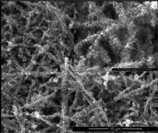Crossref Citations
This article has been cited by the following publications. This list is generated based on data provided by
Crossref.
Athauda, Thushara J.
Hari, Parameswar
and
Ozer, Ruya R.
2013.
Tuning Physical and Optical Properties of ZnO Nanowire Arrays Grown on Cotton Fibers.
ACS Applied Materials & Interfaces,
Vol. 5,
Issue. 13,
p.
6237.
Athauda, Thushara J.
Butt, Umaiz
and
Ozer, Ruya R.
2013.
One-dimensional hierarchical composite materials based on ZnO nanowires and electrospun blend nanofibers.
RSC Advances,
Vol. 3,
Issue. 44,
p.
21431.
Athauda, Thushara J.
and
Ozer, Ruya R.
2013.
Nylon Fibers as Template for the Controlled Growth of Highly Oriented Single Crystalline ZnO Nanowires.
Crystal Growth & Design,
Vol. 13,
Issue. 6,
p.
2680.
Athauda, Thushara J.
Madduma-Bandarage, Ujith S. K.
and
Vasquez, Yolanda
2014.
Integration of ZnO/ZnS nanostructured materials into a cotton fabric platform.
RSC Adv.,
Vol. 4,
Issue. 106,
p.
61327.
Gao, Likun
Zhan, Xianxu
Lu, Yun
Li, Jian
and
Sun, Qingfeng
2015.
pH-dependent structure and wettability of TiO2-based wood surface.
Materials Letters,
Vol. 142,
Issue. ,
p.
217.
Ashraf, Munir
Champagne, Philippe
Perwuelz, Anne
Campagne, Christine
and
Leriche, Anne
2015.
Photocatalytic solution discoloration and self-cleaning by polyester fabric functionalized with ZnO nanorods.
Journal of Industrial Textiles,
Vol. 44,
Issue. 6,
p.
884.
Dalvand, Ramazanali
Mahmud, Shahrom
Rouhi, Jalal
and
Raymond Ooi, C.H.
2015.
Well-aligned ZnO nanoneedle arrays grown on polycarbonate substrates via electric field-assisted chemical method.
Materials Letters,
Vol. 146,
Issue. ,
p.
65.
Ognibene, G.
Cristaldi, D. A.
Fiorenza, R.
Blanco, I.
Cicala, G.
Scirè, S.
and
Fragalà, M. E.
2016.
Photoactivity of hierarchically nanostructured ZnO–PES fibre mats for water treatments.
RSC Advances,
Vol. 6,
Issue. 49,
p.
42778.
Gao, Xiaoyu
Wen, Gang
and
Guo, Zhiguang
2018.
Durable superhydrophobic and underwater superoleophobic cotton fabrics growing zinc oxide nanoarrays for application in separation of heavy/light oil and water mixtures as need.
Colloids and Surfaces A: Physicochemical and Engineering Aspects,
Vol. 559,
Issue. ,
p.
115.
Celik Bedeloglu, Ayse
and
Islek Cin, Zeynep
2019.
Functional sol-gel coated electrospun polyamide 6,6/ZnO composite nanofibers.
Journal of Polymer Engineering,
Vol. 39,
Issue. 8,
p.
752.
Lu, Fang
Wang, Jinguang
Chang, Zhenjun
and
Zeng, Jing
2019.
Uniform deposition of Ag nanoparticles on ZnO nanorod arrays grown on polyimide/Ag nanofibers by electrospinning, hydrothermal, and photoreduction processes.
Materials & Design,
Vol. 181,
Issue. ,
p.
108069.
Zhao, Lijun
Yin, Meng
Lan, Weiwei
Wei, Yan
Hou, Jinchuan
Chen, Weiyi
and
Huang, Di
2021.
Zinc oxide crystals growth on polyamide nanofibers and their conductive and biological properties.
Journal of Crystal Growth,
Vol. 576,
Issue. ,
p.
126375.
Bavasso, Irene
Sbardella, Francesca
Bracciale, Maria Paola
Lilli, Matteo
Tirillò, Jacopo
Di Palma, Luca
Felici, Anna Candida
and
Sarasini, Fabrizio
2021.
Functionalization of Commercial Electrospun Veils with Zinc Oxide Nanostructures.
Nanomaterials,
Vol. 11,
Issue. 2,
p.
418.
Gadhi, Tanveer A.
Qureshi, Aizaz
Channa, Najeebullah
Mahar, Rasool Bux
Chiadò, Alessandro
Novara, Chiara
and
Tagliaferro, Alberto
2021.
Bi2O3/nylon multilayered nanocomposite membrane for the photocatalytic inactivation of waterborne pathogens and degradation of mixed organic pollutants.
Environmental Science: Nano,
Vol. 8,
Issue. 1,
p.
342.
Zhu, Xiao
Feng, Shasha
Rao, Yuanyuan
Ju, Shengui
Zhong, Zhaoxiang
and
Xing, Weihong
2022.
A novel semi-dry method for rapidly synthesis ZnO nanorods on SiO2@PTFE nanofiber membrane for efficient air cleaning.
Journal of Membrane Science,
Vol. 645,
Issue. ,
p.
120206.
Bavasso, Irene
Tirillò, Jacopo
Lampani, Luca
and
Sarasini, Fabrizio
2023.
Effect of ZnO-decorated electrospun veils on the damage tolerance of CFRP laminates.
Composites Communications,
Vol. 40,
Issue. ,
p.
101619.
Kim, Jungkyu
Park, Sangwoo
Jung, Seungoh
Yun, Heecheol
Choi, Kyusuk
Heo, Gyeom
Jin, Hyoung-Joon
Park, Subong
and
Kwak, Hyo Won
2023.
Biodegradation behavior of polybutylene succinate (PBS) fishing gear in marine sedimentary environments for ghost fishing prevention.
Polymer Degradation and Stability,
Vol. 216,
Issue. ,
p.
110490.
Kim, Jungkyu
Yun, Heecheol
Won, Sungwook
Lee, Donggil
Baek, Suyeon
Heo, Gyeom
Park, Subong
Jin, Hyoung-Joon
and
Kwak, Hyo Won
2024.
Comparative degradation behavior of polybutylene succinate (PBS), used PBS, and PBS/Polyhydroxyalkanoates (PHA) blend fibers in compost and marine–sediment interfaces.
Sustainable Materials and Technologies,
Vol. 41,
Issue. ,
p.
e01065.



